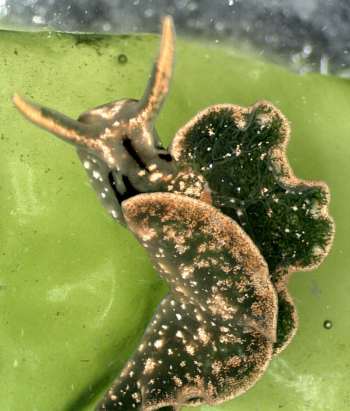
Elysia hirasei
Baba, 1955
Order: SACOGLOSSA
Superfamily: ELYSIOIDEA
Family: Elysiidae
DISTRIBUTION
Known previously from Japan. Reported on Forum from Thailand and Hong Kong.
PHOTO
Locality: Marine Reserve, Hong Kong, China, South China Sea. in fish tank. Length: ~3 cm. Dec 2004. Photographer: Andy Cornish
The body is translucent with a greenish tinge all over from the algal material in the fine digestive gland branches ramifying throughout the body. Creamy brown pigmentation forms a band which runs from the tip of one rhinophore, across the head and out to the tip of the other rhinophore. There is also a cramy brown band of irregular width at the edge of the parapodia, broader on the outer side than on the inside. Patches of the same colour are scattered over the outside of the parapodia, and a few are found on the inside. There is a black median band on the head running from the rhinophores back to the parapodia. There is also a distinctive black patch on each side at the anterior extremity of the parapodia. The patch divides into two lines on each side running forward above and below the eye.
This species was identified (Baba, 1949: Pl VIII, fig 25) as Elysia viridis, but Baba (1955) renamed it E. hirasei.
- Baba, K (1949) Opisthobranchia of Sagami Bay collected by His Majesty The Emperor of Japan. Iwanami Shoten, Tokyo. 194pp., 50 Pls.
- Baba, K. (1955) Opisthobranchia of Sagami Bay, Supplement. Iwanami Shoten: Tokyo. 59pp., 20 Plates.
Rudman, W.B., 2005 (April 14) Elysia hirasei Baba, 1955. [In] Sea Slug Forum. Australian Museum, Sydney. Available from http://www.seaslugforum.net/find/elyshira
Related messages
South African Elysia
April 8, 2010
From: Richard Barnes

Dear Bill
Do you by any chance recognize this tiny (5mm long) Elysia found reasonably commonly on intertidal Zostera capensis in the mouth of the Knysna marine embayment, Western Cape, South Africa (34 04S, 23 04E)?
Locality: Knysna, low spring tide, Rep South Africa, Indian, 1 April 2010, Eel-grass growing on sand. Length: 5 mm. Photographer: RSK Barnes.
Kind regards
Richard
rsb1001@cam.ac.uk
Barnes, R.S.K., 2010 (Apr 8) South African Elysia. [Message in] Sea Slug Forum. Australian Museum, Sydney. Available from http://www.seaslugforum.net/find/23432Dear Richard,
From Terry Gosliner's book, Knysna has a large endemic opisthobranch fauna but also a good number of Atlantic and Indo-West Pacific representatives, so this could be a species described from far afield. I can't find a South African record of an elysiid fitting your animal and the black markings on the head are very distinctive. The only species that comes to mind is Elysia hirasei which was described from Japan but has been recently reported on the Forum from western India [#22747]. The lack of a pinkish ventral patch could well be because of the juvenile nature of your animal.
It's possible I am quite wrong, as we still have a lot of sorting out to in this group, but the pattern of black markings is very distinctive.
Best wishes,
Bill Rudman
Re: Elysia hirasei? from Ratnagiri
November 4, 2009
From: Vishal Bhave


Concerning message #22738:
Dear Bill,
I also contacted Kathe Jensen who thinks the specimen is Elysia hirasei. and she hoped some Japanese experts more familiar with the species could confirm it on the Seaslugforum
But, I think the red spot in mid head region is distinct as I have collected around 60+ specimens from many localities of Maharashtra, India, feeding on various algae (Chaetomorpha cf. media, Ulva sp., Enteromorpha sp.). Yestrday we collected them on bryozoans and other rocky substrates.
All those specimen has got the distinct Black markings (3 bands between rhinophores) with reddish-orange spot on central band in between 2 black bands . There is also a distinctive black patch on each side running forward above the eye.
Size ranges from 1.5 mm. (that is what i can observe ) to 9 mm.
Locality: Ratnagiri, Kunkeshwar, Undi - Ratnagiri; Vayangani, Vada-vetye-Sindhudurga, 10-15 centimeters, Maharashtra, India, Arabian sea, 19 October 2009, Intertidal, beneath the rock, on algae, in rockpool. Length: 02-08 mm. Photographer: Vishal Bhave.
Vishal Bhave
vishalbhave@gmail.com
Bhave, V.J., 2009 (Nov 4) Re: Elysia hirasei? from Ratnagiri. [Message in] Sea Slug Forum. Australian Museum, Sydney. Available from http://www.seaslugforum.net/find/22747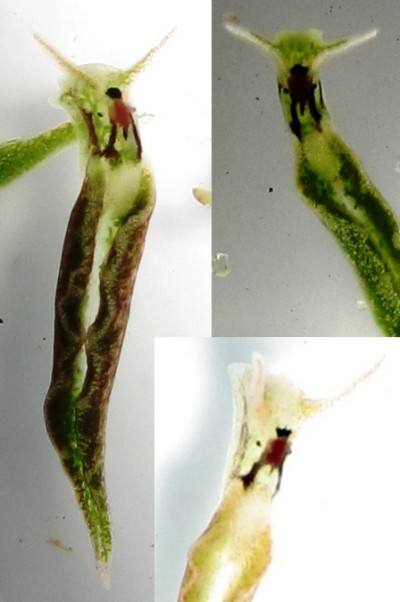
Dear Vishal,
Thanks for the extra photos and your comments. I agree with Kathe Jensen that this is most probably E. hirasei. Identifying opisthobranchs is not an exact science even with a knowledge of their anatomy. The problem at present is that we know very little about most species. In the case of many species of Elysia we know little about their geographic distribution, their biology and natural history, or their colour variability. Colour variation can occur within a single population at a particular place and it can also occur between populations scattered over vast geographic distances. We also know that in some species the background colour can change depending on the colour of the algae they are eating, or whether they are starving or full of food. I guess the colour variation we can see in your animals - from green to brown to pale yellow - is a result of food colour.
Concerning the black markings. They are certainly the same, or very similar, to those of Japanese specimens of E. hirasei. The red-pink spot in your animals has not been reported from Japan, but is could be an example of geographic colour variation where isolated populations of a widespread species can develop differences in their colour pattern. Another interesting possibility is that this is another example of black pigmentation being replaced by pink or orange as occurs in a number of chromodorid species such as Chromodoris hamiltoni. Certainly in some of your photos the pinkish spot is almost black.
At this stage I think it is best to consider this species to be a form of E. hirasei. It may take years before we have a full picture of colour variability in this species - or group of species. At present the only records between Japan and India are those on the Forum from Hong Kong and Thailand. We clearly need more from India and Japan as well as the long coastline in between.
Best wishes,
Bill Rudman
Re: Elysia hirasei? from India
November 3, 2009
From: Vishal Bhave

Dear Bill
Today I got a swarm of Sacoglossans on a bed of green algae Chaetomorpha cf. media about 60 animals in and area of about 30 cm x10 cm X 15 cm (shape is cliff like).
Locality: Mirya, Maharashtra, India (towards open sea, surf beaten Area) on a bed of Chaetomorpha Size of animal ranges from 06 mm to 18 mm. October 2009
Head has characteristic 3 black lines between rhinophores and eye spot and anterior end of mantle flaps. Also between those three lines there is bright orange spot
Vishal Bhave.
vishalbhave@gmail.com
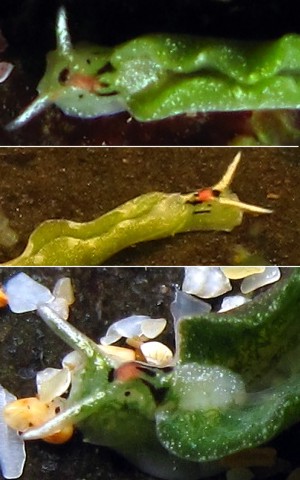
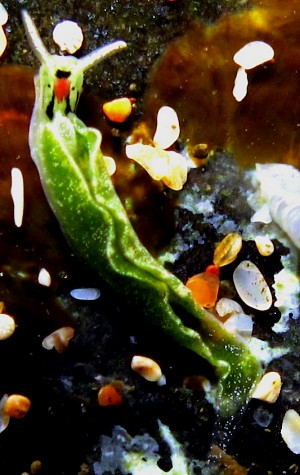
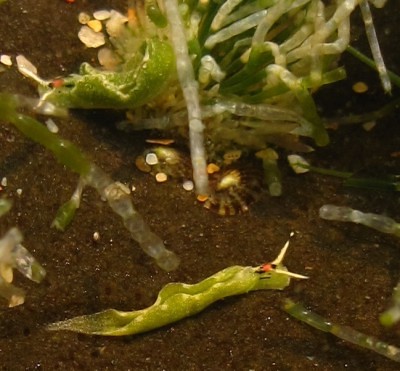
Dear Vishal Bhave,
The only species of Elysia I know with similar black lines is Elysia hirasei which was originally described from Japan but we have records on the Forum from Hong Kong and Thailand. The bright orange spot in your Indian animals has not been reported before, but perhaps it is a geographical variation? It woud be intersting to have Kathe Jensens' opinion
Best wishes,
Bill Rudman
Re: Identification of an Elysia from Hong Kong
January 23, 2009
From: Cynthia D. Trowbridge

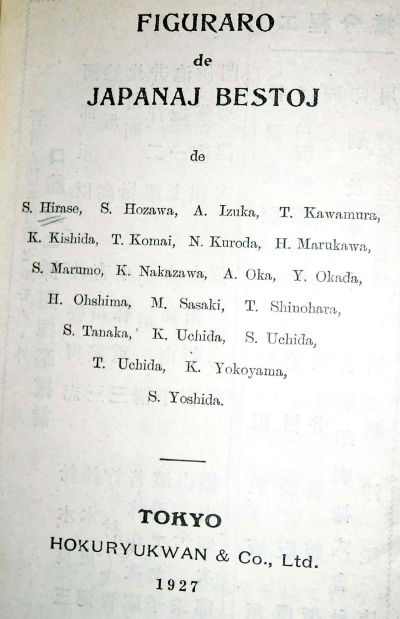
Concerning message #13429:
Dear Bill,
I was fascinated to discover about Elysia hirasei from your messages in 2005. Almost 4 years later and I have finally located the original description of this species (as Elysia viridis ) by Hirase (1927).
I presume that the copyright has expired on this so am sending a digital photo of the the radular teeth of E. hirasei as drawn by Hirase (1927). To my knowledge, Baba never illustrated the teeth. They are heavily serrated and blade shaped.
Here is the reference:
-
Hirase, S. et. al (1927) Figuraro de Japanaj Bestoj. Hokuryukwan & Co., Ltd. Tokyo. p. 1476
All the best,
Cordially,
Cynthia
sacoglossans@ymail.com
Trowbridge, C.D., 2009 (Jan 23) Re: Identification of an Elysia from Hong Kong. [Message in] Sea Slug Forum. Australian Museum, Sydney. Available from http://www.seaslugforum.net/find/22184Dear Cynthia,
Thanks very much for passing this on. Following old references can open a can of worms! I am not sure just what status Hirase's description has in nomenclature. Although Baba (1949) refers to Hirase (1927) I think what Baba describes in 1949 is as far back as we can go in nomenclatural terms. Both Hirase (1927) and Baba (1949) identify the animal [incorrectly] as Elysia viridis Montagu.
In Baba (1955) where he gives the species a new name - E. hirasei - he makes it clear that not all the illustrations identified as E. viridis in 1949 are his new species E. hirasei. He specifically lists a colour painting Plate VIII fig 25 (non fig 26) and a Text Fig 24 as representing E. hirasei Baba n.n.
It has the characteristic black markings on the 'neck' as illustrated on the Fact Sheet, but on looking at his Text Fig 24 of the radula with my naked eye the teeth appear non-denticulate, although fine denticulations are described in the text. Your copy of Hirase's made me curious so I examined Baba's illustration with a magnifying glass and sure enough there are very fine denticulations visible. I must say it's a bit of a trap when you need to read a book with a microscope!
Fortunately Baba specifically excludes Plate VIII fig 26 which shows a species with a blue tip to the tail and blue tips to the rhinophores which places it right in the middle of the E. abei - E. amakusana confusion.
Thanks for these illustrations Cynthia. It is nice to be able to identify one of these Elysia species with confidence.
Best wishes,
Bill Rudman
Re: Identification of an Elysia from Hong Kong
April 14, 2005
From: Kathe R. Jensen
Dear Bill & Allen,
Concerning message #12934: Now with the Easter holidays I have finally had the time to look at some of the sacoglossan messages that have been posted on the Forum over the last couple of month (except the ones that I have been able to answer right away).
The Elysia from Hong Kong is probably E. hirasei Baba, 1955. This species was illustrated as E. viridis on Fig. 25 in Baba's Sagami Bay monograph (1949), and described as a separate species in the Supplement to that book in 1955. The black lines on the head are identical, and colour pattern also fits. This will be a new record from Hong Kong, but I also found this species in Phuket, Thailand many years ago (1986 I think). I found it on some thin filamentous algae, possibly Rhizoclonium, and I was able to keep them alive by feeding them Chaetomorpha after my return to Denmark. Unfortunately they died over a weekend, so I do not have preserved specimens.
Best wishes,
Kathe
krjensen@zmuc.ku.dk
Jensen, K.R., 2005 (Apr 14) Re: Identification of an Elysia from Hong Kong. [Message in] Sea Slug Forum. Australian Museum, Sydney. Available from http://www.seaslugforum.net/find/13429Dear Kathe,
Thanks for that - now that you tell me - the black markings in the painting in Baba (1949) are indeed identical to the one from Hong Kong. It is a very distinctive colour pattern.
Best wishes,
Bill Rudman
Identification of an Elysia from Hong Kong
February 5, 2005
From: Allen To

Dear Bill
I recently retrieved a sea hare in a fish tank at the only marine reserve in Hong Kong, China. The reserve is at southern part of Hong Kong. The fish tank has a circulation system that direclty receives sea water from nearby waters so the sea hare probably get "sucked" into the tank. I have spent some time looking through available info on the web in search of the sea hare ID but none seems to match very well. I would be much grateful if you could help give me info on the ID of this sea hare. Attached is the picture of that 3cm sea hare.
Locality: Marine Reserve, Hong Kong, China, South China Sea. in fish tank. Length: ~3 cm. Dec 2004. Photographer: Andy Cornish
Thank you very much.
Best regards,
Allen
allenwlto@yahoo.com


Dear Allen,
This is not a Sea Hare, but is a member of another group of Sea Slugs - the Sacoglossans. It is a species of Elysia but I can't recall a species with black lines on the head, as in your animal. Sacoglossans are quite interesting because they feed by sucking cell contents out of green algal cells. Some of them have become solar powered by retaining chloroplasts, the part of the plant cell which photosynthesises, alive and functioning in their own bodies. The dark green patches you can see in your photos, especially on the inside of the parapodia, are accumulations of chloroplasts. The lower right photo is a close-up of one of your photos to show the branching network of blood vessels found throughout the parapodia, no doubt associated with the high metabolic activity occurring there.
Concerning the identity of your species. Hopefully Kathe Jensen will be able to give us some clues to its identity.
Best wishes,
Bill Rudman
